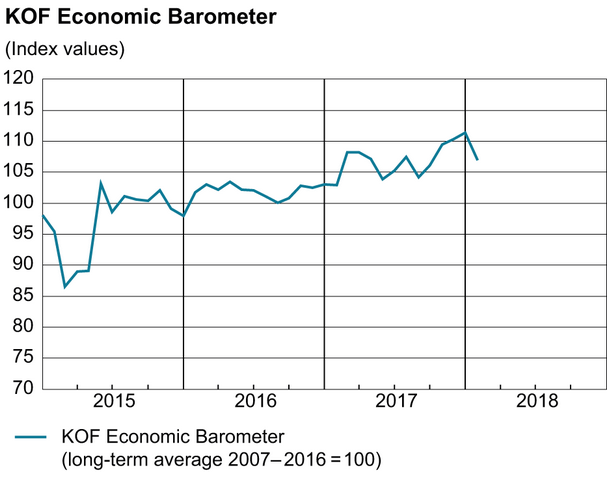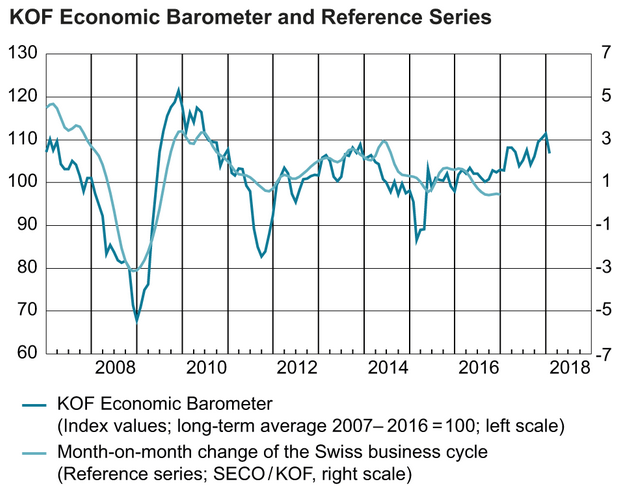In January, the KOF Economic Barometer does not continue its upward tendency, which started in September 2017, but has declined. However, despite the decline, the indicator remains well above its long-term average. It still indicates a more dynamic economic development than in mid-2017. The recovery of the Swiss economy is thus likely to continue, albeit with slightly less momentum than indicated in the past few months. In January 2018, the KOF Economic Barometer declined compared to the previous month (revised to 111.4 from 111.3) by 4.5 points to a value of 106.9. Despite the decline, the indicator remains well above its long-term average and the recovery of the Swiss economy is thus likely to continue. Declines
Topics:
KOF Zurich considers the following as important: Featured, newsletter, Swiss and European Macro, Switzerland KOF Economic Barometer
This could be interesting, too:
Nachrichten Ticker - www.finanzen.ch writes Die Performance der Kryptowährungen in KW 9: Das hat sich bei Bitcoin, Ether & Co. getan
Nachrichten Ticker - www.finanzen.ch writes Wer verbirgt sich hinter der Ethereum-Technologie?
Martin Hartmann writes Eine Analyse nach den Lehren von Milton Friedman
Marc Chandler writes March 2025 Monthly
In January, the KOF Economic Barometer does not continue its upward tendency, which started in September 2017, but has declined. However, despite the decline, the indicator remains well above its long-term average. It still indicates a more dynamic economic development than in mid-2017. The recovery of the Swiss economy is thus likely to continue, albeit with slightly less momentum than indicated in the past few months.
| In January 2018, the KOF Economic Barometer declined compared to the previous month (revised to 111.4 from 111.3) by 4.5 points to a value of 106.9. Despite the decline, the indicator remains well above its long-term average and the recovery of the Swiss economy is thus likely to continue.
Declines in the manufacturing and the banking sector are mainly responsible for this weakening. At the same time, the indicators for the hotel and restaurant industry, the export development, the construction sector and private consumption are also easing in January. Within the manufacturing industry, the worse overall outlook was primarily driven by the chemical, electrical, wood-processing and textile industries. On the other hand, the prospects for the machine-building and food industry have brightened. The overall markedly deteriorated sentiment in the manufacturing sector is primarily a reflection of the more negative assessment of incoming orders. By contrast, the indicators for the competitive and profit situation cushioned the downward tendency. |
KOF Economic Barometer, January 2018(see more posts on Switzerland KOF Economic Barometer, ) Source: kof.ethz.ch - Click to enlarge |
KOF Economic Barometer and reference time series: annual updateIn September 2017, the scheduled annual update of the KOF Economic Barometer took place. The annual update of the Barometer concerns the following steps: redefinition of the pool of indicators that enter the selection procedure, update of the reference time series and renewed execution of the variable selection procedure. The updated reference series is the smoothed continuous growth rate of the Swiss Gross Domestic Product (GDP) according to the new System of National Accounts ESVG 2010, released in early September 2017, which takes into account the release of the previous year’s annual GDP data by the Swiss Federal Statistical Office. As a result of the indicator variable selection procedure, the updated KOF Economic Barometer is now based on 273 indicators (instead of 272 as in the previous vintage) from a pool of almost 500 potential indicator series. They are combined using statistically determined weights. |
KOF Economic Barometer and Reference Series, January 2018(see more posts on Switzerland KOF Economic Barometer, ) Source: kof.ethz.ch - Click to enlarge |
Tags: Featured,newsletter,Switzerland KOF Economic Barometer
